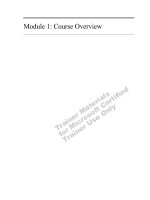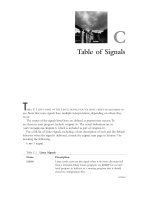Course overview linux and C
Bạn đang xem bản rút gọn của tài liệu. Xem và tải ngay bản đầy đủ của tài liệu tại đây (1.38 MB, 42 trang )
15
-
123
15
-
123
Systems Skills in C and Unix
About the course
About the course
Effective Programming in C and
UNIX
All Semesters: 9 units
This course is designed to provide a substantial exposure to the C programming
language and the Unix programming environment for students with some prior
programming experience but minimal exposure to C.
Features of the C language that are emphasized
arrays, structs and unions, dynamic memory allocation (malloc and free), pointers, pointer
arithmetic, and casting.
Data structures that are emphasized
Data structures that are emphasized
dynamic lists and hash tables.
Algorithmic efficiency is emphasized
Space and time complexity
Students will develop a sense of proper programming style in the C idiom
be exposed to cross-platform portability issues.
learn to use tools such as emacs/vi, make, gdb to assist them in the design,
testing and debugging programs. learn about regular expressions and will be
able to use scripting languages such as Perl and Shell scripting
This course serves as the prerequisite for 15-213.
Prerequisites: 15-110
Course material
Primary Course Text Books:
All course textbooks are optional. Lecture notes are available from
(1) />(2) C Programming Language (2nd Edition) by Brian W. Kernighan (Author), Dennis
Ritchie (Author)
Other Recommended Text Books are:
(3) "C for Java Programmers" by
Thomasz
Muldner
" ISBN: 0
-
201
-
70279
-
7
-
Addison
(3) "C for Java Programmers" by
Thomasz
Muldner
" ISBN: 0
-
201
-
70279
-
7
-
Addison
Wesley Longman 2000
(4) ANSI C on UNIX by Paul Wang />(5) Learning Perl, Fourth Edition by Randal L. Schwartz, Tom Phoenix, brian d foy
Fourth Edition July 2005 />(6) The UNIX programming Environment by Kernighan and Pike
/>Course Components
8 programming labs – 40%
skills labs – 7%
Quizzes or Salons – 10%
Written midterm – 10%
C programming midterm
–
7%
C programming midterm
–
7%
Script programming midterm – 5%
Final Exam – 20%
TA points – 1%
Course Objectives
At the end of this course
You should be able to write fairly sophisticated C
programs
You should have a good understanding of program
verification, debugging (tools and process)
You should have a good understanding of machine
You should have a good understanding of machine
memory model and how programs work
You should be able to write useful scripts using
languages such as perl and bash
You will have some understanding of how assembler s
work
You should be prepared to go into 15-213
Course Staff
Professor Guna ( /> Gates 6005, office hrs – T, TR 10:30-12:00 or by
appointment, or anytime my door is open
Course Assistants
Section A
TBA
TBA
Section E
Emily Grove
Section F
Kee Young Lee
Section G
Sylvia Han
How your time should be divided
This is how you should spend your time on any week (9
units)
Attending lecture
3 hours
Recitation
1 hour
Homework and Coding
Homework and Coding
5 hours
Disclaimer
It is hard to predict how long it will take you to finish your
programming assignment
Talk to the course staff, if it is taking an unusually long time
(20 hour /week)
We will be tracking this time as part of the assignment
Important
Start assignments early – C programming can be very time
consuming
Assignments are individual, do not ask others to write code or
copy others code w/o permission
Sample code given in class can be used in any assignment
Read notes and annotated notes
Read notes and annotated notes
Do homework
Not graded
Attend lectures and recitations
DO NOT use laptops other than to take notes in class or write
code
Any other activity is prohibited
Seek help early and often
Testing your prior knowledge
Testing your prior knowledge
What is a function?
A mathematical notion is that a function takes a given
set of inputs and produces one and only one output
Hence for the same set of inputs it must always produce
the same output
Functions can be used in programming to
Divide and
conquer
Divide and
conquer
Promote modularity
Unit testing
proof of correctness of the algorithm
Functions have overhead
Change in execution path
Runtime stack use
What is the purpose of the following function?
int f(int n) {
int i = 0, k = 0;
while (k <= n) {
k += i*2 + 1;
i++;
}
return i-1;
}
Write down the assumptions you make about this
function
What is a Loop?
A programming constructs that allows one to repeat a
task
What are the types of loops you know? When do you
use them?
Does a loop always ends? Give an example where a
loop does not end.
Does a loop always execute once? Give an example,
where a loop may never execute.
for loop syntax (revisited)
for (initializations; exit condition; change)
{
/* loop_ body */
/* loop_ body */
}
while loop syntax (new)
while (condition(s))
{
/* loop body */
v
Initialize conditions
/* loop body */
}
v
Loop condition
changes
When loops go wrong
Loop invariant
A loop invariant is a boolean variable that is true
before, during and just after execution of the loop
Example: What would be a loop invariant for
Proving the Loop invariance
Check the loop invariant
Is it true just before loop execution?
Does it hold during the execution of the loop?
Is it true just after the execution of the loop
What are pre and post conditions for this function?
What are Strings?
String is an array of characters
Characters come from ASCII (8-bit) or Unicode (16-
bit) tables
Memory is a big long String of bytes
In Java
In Java
Strings are objects with their own attributes and
operations (methods)
Strings are immutable
Strings are very common in many applications
In C Strings are not objects and is a byte array of
characters ending with NULL character ‘\0’
What are boolean variables?
Boolean variables only takes values TRUE or FALSE
C does not have boolean as a type
Use o for false and 1 for true
Technically we can use a byte to store things
The condition in an if statement is a boolean variable
Boolean variables can be combined using
Boolean variables can be combined using
Logical AND (&&)
Logical OR (||)
Logical NOT (!)
Properties
NOT (A and B) = NOT (A) or NOT(B)
NOT (A or B) = NOT (A) and NOT(B)
Prove these identities
Logic Tables
Source: mathworks
Prove !(A && B) = !A || !B
Homework:
prove
!(A
||
B) = !A
&&
!B
!(A
||
B) = !A
&&
!B
Understanding UNIX
Understanding UNIX
Operating Systems









